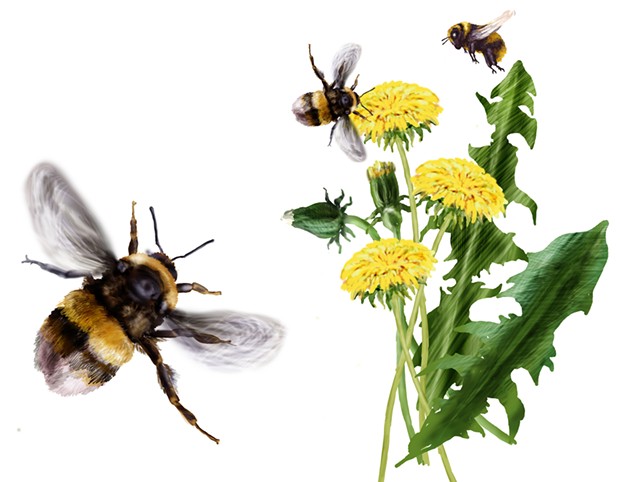[
{
"name": "Top Stories Video Pair",
"insertPoint": "7",
"component": "17087298",
"parentWrapperClass": "fdn-ads-inline-content-block",
"requiredCountToDisplay": "1"
}
]
This week, I'm turning my focus to a problem that most gardeners are dealing with this month, thanks to the intermittent rain/sun/rain/warmth/rain/wind we've had over the past two months. You may have noticed that you have to mow the grass more often right now, but it's not just the grass that's growing like, well, a weed. It's weeds growing like weeds. But what is a weed? According to A.A. Milne, "Weeds are flowers too, once you get to know them."
While researching this article, I did a quick online search for weeds — please note to make the word plural because even if you type "Humboldt County weeds," you still get a few results about our best known plant. The majority of non-cannabis-related websites talked about eradication, which is kind of a bummer. Not all weeds are bad.
One of the most maligned "weeds," of course, is the dandelion, especially if it has the nerve to grow in your manicured lawn. But let's take a closer look at this prolific so-called weed. It may surprise you to learn that all parts of the dandelion are edible. The leaves are most often eaten, in salads or stir frys. Harvest them when they're young, before the flowers bloom, as they become more bitter the older they get. The greens are high in vitamins A, B, C, E and K.
The flowers are also edible. Pop them in salads or in your scrambled eggs. And let's not forget wine. Yes, you can make wine out of dandelion flowers. If you do decide to explore the wonderful world of eating dandelions, make sure you harvest from spaces that have not been sprayed with nasty chemicals. Beekeepers are among the few groups who love dandelions dearly because they bloom early and often, and bees love the flowers. In addition, dandelion roots are actually good for your lawn, drawing calcium up from lower depths of the soil, aerating the soil and reducing erosion. So the next time you reach for that bottle of herbicide, consider leaving those cheerful yellow flowers in your lawn. The bees will thank you.
Weeds, such as they are, can also tell you a lot about your soil. Do you have a lot of creeping buttercup (Ranunculus repens)? This means your soil is damp — buttercup thrives in swampy areas. Another weed that thrives in damp areas is willow weed, which has strappy leaves and tiny pink flowers along the stalk. It's quite easy to pull out if you don't want it to reseed. Perhaps you have a lot of clover in your lawn or flower beds. You may have a nitrogen deficiency in the soil. But fear not! If you leave the clover, it will actually fix nitrogen in the soil, thus feeding the area it's in. It also draws up trace minerals and, as it decomposes, it will provide those nutrients back to the soil and the grass. It will reseed heartily, so if you don't want your entire blueberry patch overtaken, you might want to consider moving it to another area. I must also mention that bees love clover, too, turning it into a lovely light colored honey.
I could write an entire Journal's worth of pages about plants that are considered weeds here in Humboldt, some of which are definitely more pernicious than others. (Bindweed, anyone?) While there are a few weeds I try to keep under control or pull out completely, others are allowed to coexist with the gardens, both at home and at my clients' places. Before you judge the plant/weed too harshly, find out what it is. Your local nurseryperson will probably be able to ID it for you and there are several Humboldt-specific plant pages on Facebook. Often, folks will post a photo of a plant asking for identification and the avid gardeners, landscapers and nursey plant growers on the pages are more than happy to answer plant ID questions.
A couple more plants that are considered weeds here in Humboldt but aren't as nasty as the evil bindweed are sheep sorrel and self-heal. Sheep sorrel (Rumex acetosella) loves acid soil, so a good way to deal with it is by making the soil more alkaline. Sheep sorrel is also edible. Pick before it blooms. Self-heal (Prunella vulgaris) is a sweet little plant with a purple flower spike that pollinators love. It's not particularly aggressive, so I let it grow in my garden.
Before you reach for the herbicides, get to know the weeds in your garden. You might be surprised to learn they're not as nasty as you think. Especially if they're in your lawn.
Julia Graham-Whitt (she/her) is owner and operator of the landscaping business Two Green Thumbs.
Comments
Showing 1-1 of 1
more from the author
-
Working it Out in the Garden
- Jan 18, 2024
-
Winter Planting for Future Color
- Dec 21, 2023
-
Equinoctial To-Do and Native Plants
- Sep 21, 2023
- More »
































